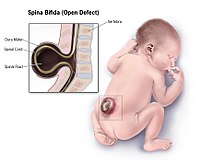
Photo from wikipedia
It has been estimated that 60-70% of neural tube defects (NTDs) have a genetic component, but few causative genes have been identified. The lack of information on genes associated with… Click to show full abstract
It has been estimated that 60-70% of neural tube defects (NTDs) have a genetic component, but few causative genes have been identified. The lack of information on genes associated with non-syndromic NTDs in humans is especially notable as the "genomic revolution" has led to new tools (e.g., genome-wide genotyping arrays, next-generation sequencing) that are helping to elucidate the full spectrum of genetic variation (from common to rare) contributing to complex traits, including structural birth defects. However, the application of modern genomic approaches to the study of NTDs has lagged behind that of some other common structural birth defects. This may be due to the difficulty of assembling large study cohorts for anencephaly or spina bifida. The purpose of this review is to outline the evolution of genetic studies of NTDs, from studies of familial aggregation to candidate gene and genome-wide association studies, through whole-exome and whole-genome sequencing. Strategies for addressing gaps in NTD genetic research are also explored.
Journal Title: Journal of pediatric rehabilitation medicine
Year Published: 2017
Link to full text (if available)
Share on Social Media: Sign Up to like & get
recommendations!